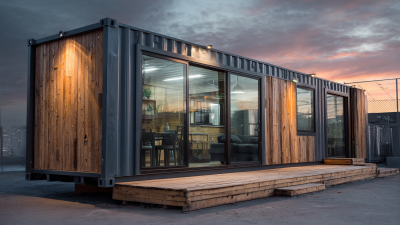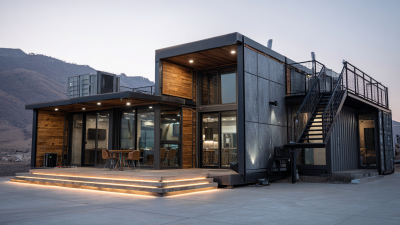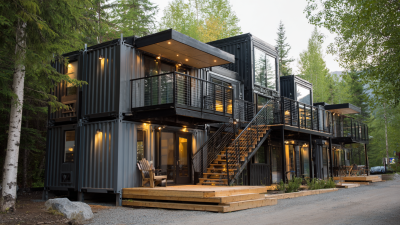In recent years, the concept of sustainable living has gained significant traction, with innovative housing solutions like the Living Container House emerging as a viable alternative to traditional housing. According to the Global Sustainable Housing Report (2022), the need for eco-friendly homes is increasingly recognized, as urban areas are expected to accommodate 68% of the world's population by 2050. Living Container Houses not only utilize repurposed shipping containers, thereby reducing waste and carbon footprint, but also offer a flexible, cost-effective housing solution. The World Green Building Council reports that such innovative designs can lead to a reduction in energy usage by up to 60%, addressing the pressing issues of climate change and housing shortages. As we explore the benefits and innovations inherent in Living Container Houses, it becomes clear that this trend is not just a fleeting fad but a pivotal component of sustainable urban development.

The rise of living container houses marks a significant shift in the pursuit of sustainable housing solutions. By repurposing shipping containers, architects and homeowners alike are embracing an innovative approach that not only reduces waste but also minimizes the carbon footprint associated with traditional construction methods. These structures offer flexibility in design and functionality, allowing for creative urban layouts while addressing the pressing need for affordable housing.
In addition to their eco-friendly credentials, living container houses come equipped with a variety of innovative features that enhance energy efficiency and comfort. Many designs incorporate sustainable technologies such as solar panels, green roofs, and rainwater harvesting systems, which further reduce reliance on conventional utilities. As urban populations continue to grow, these container homes stand out as a viable alternative, combining modern living with environmental responsibility and opening new avenues for sustainable urban development.

Container homes have emerged as a pioneering solution for sustainable living, showcasing innovative design features that maximize energy efficiency. One striking aspect of these homes is their ability to utilize passive solar design. By strategically positioning windows and employing thermal mass, container homes can naturally regulate indoor temperatures. According to a report by the U.S. Department of Energy, homes that incorporate passive solar design can reduce energy costs by up to 30%, significantly lowering the environmental impact associated with traditional housing.
In addition to passive solar techniques, many container homes integrate advanced insulation materials, which are crucial for maintaining energy efficiency. Spray foam and rigid foam insulation can boost energy performance, reducing the need for heating and cooling systems. A study from the National Renewable Energy Laboratory found that well-insulated homes can decrease energy consumption by nearly 50%, leading to substantial savings over time.
Tip: When considering a container home, prioritize the orientation and location of windows to harness natural light and warmth effectively.
Another innovative feature is the installation of renewable energy systems, such as solar panels and wind turbines, which further enhance energy independence. The integration of these technologies allows homeowners to significantly reduce their reliance on grid electricity, contributing to a more sustainable lifestyle.
Tip: Research local incentives for renewable energy installations, as many regions offer tax breaks or rebates for sustainable home improvements.
The cost-effectiveness of shipping container homes compared to traditional houses continues to gain traction as a viable solution for sustainable living. With their low-cost and quick construction features, these innovative housing options are increasingly appealing to prospective homeowners. Recent data suggests that the container homes market size is projected to reach USD 95.74 billion by 2033, growing from USD 60.02 billion in 2024, indicating a robust compound annual growth rate (CAGR) as more individuals seek affordable alternatives in the housing market.
Moreover, while container houses typically come with a thinner and lighter envelope structure, this can lead to high energy consumption if not properly managed. A multidimensional assessment reveals that investing in improved insulation and energy-efficient systems can significantly mitigate these concerns, making them not only a cost-effective solution in terms of construction but also enhancing their long-term economic viability. As such, the integration of modern comforts with eco-friendly designs positions shipping container homes as a forward-thinking choice for addressing housing needs in an increasingly environmentally conscious society.
Living container houses offer a remarkable solution for sustainable living, particularly through their use of recycled shipping containers. This innovative approach not only repurposes materials that might otherwise contribute to landfill waste but also significantly reduces the ecological footprint associated with traditional housing construction. By utilizing these durable containers, homeowners can enjoy a stylish and modern living space while positively impacting the environment. The energy efficiency of container houses further emphasizes their eco-friendly benefits, as they often require less energy for heating and cooling compared to conventional homes.
Tips for creating an eco-friendly living container house include maximizing natural light through window placement to minimize reliance on artificial lighting and integrating green roofs or vertical gardens. These features not only enhance the aesthetic appeal but also improve insulation and promote biodiversity. Additionally, consider using low-VOC paints and sustainable materials for interiors to maintain air quality and reduce harmful emissions within the home.
Another key factor is the potential for off-grid living. Installing solar panels or rainwater collection systems can greatly increase the sustainability of container homes. This self-sufficiency not only lowers utility costs but also helps to conserve resources, making recycled shipping container houses a smart choice for environmentally conscious living.
| Dimension | Data |
|---|---|
| Average Cost of Container Home | $25,000 - $70,000 |
| Average Lifespan of Container Homes | 25-30 years |
| Reduction in Carbon Footprint | Up to 90% |
| Energy Efficiency Rating | LEED Certified |
| Recycled Material Use | 70-90% |
| Average Time to Build | 3-6 months |
| Number of Container Homes Built Annually | Over 5,000 |
 Container homes have emerged as a sustainable living solution around the globe, with various successful communities exemplifying their advantages. These innovative living spaces appeal to both eco-conscious individuals and those seeking affordable housing options. Notable examples include communities in places like the United States, Canada, and Europe, where container homes have not only provided affordable housing but also fostered a strong sense of community among residents. The adaptability of these structures allows them to cater to diverse needs, from single-family homes to multi-unit complexes.
Container homes have emerged as a sustainable living solution around the globe, with various successful communities exemplifying their advantages. These innovative living spaces appeal to both eco-conscious individuals and those seeking affordable housing options. Notable examples include communities in places like the United States, Canada, and Europe, where container homes have not only provided affordable housing but also fostered a strong sense of community among residents. The adaptability of these structures allows them to cater to diverse needs, from single-family homes to multi-unit complexes.
Tip: If you're considering becoming part of a container home community, research local zoning laws and building codes to ensure compliance and a smooth construction process.
Moreover, container homes are inherently sustainable, utilizing repurposed shipping containers, which reduces waste in landfills. Many communities have incorporated green technologies like solar panels and rainwater harvesting systems, further enhancing their eco-friendly footprint. This trend encourages a lifestyle that prioritizes environmental health, making container homes an attractive choice for future generations.
Tip: Look for container home communities that prioritize sustainable practices and offer amenities like community gardens or shared resources to enhance your living experience.






